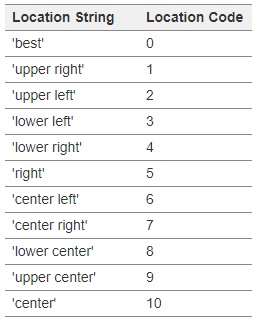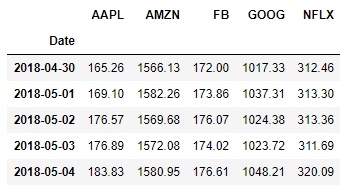Moving Averages and Statistics for Stock Prices
1. Finding Historical Prices
import requests
In site url, period1 is starting time, period 2 is ending time
site="https://query1.finance.yahoo.com/v7/finance/download/2330.TW?period1=0&period2=1549258857&interval=1d&events=history&crumb=hP2rOschxO0"
response = requests.post(site)
Now historical data of 2330.TW is stored in "response". To check text file:
print(response.text)
To save file as csv
with open('file.csv', 'w') as f:
f.writelines(response.text)
print(df.head())
To improve csv file
- parse_dates changes first column to datetime (instead of 0,1,2,3)
import pandas as pd
df = pd.read_csv('file.csv', index_col='Date', parse_dates=['Date'])
print(df.head())

import numpy as np
import pandas as pd
import pandas_datareader as pdr
import matplotlib.pyplot as plt
%matplotlib inline
Dataframe setting 2019-04-17 as starting date
gld = pdr.get_data_yahoo('GLD', '2019-04-17')
gld.head()

Compute moving averages
gld_close = pd.DataFrame(gld.Close)
gld_close['MA_9'] = gld_close.Close.rolling(9).mean().shift()
gld_close['MA_21'] = gld_close.Close.rolling(21, center=True).mean()
Make sure data doesn't have gaps
gld_close['MA_9'].head(12)
Plotting 9 days and 21 days average of gold prices
- legend(loc='upper right', shadow=True) determines position of label

plt.figure(figsize=(15,10))
plt.grid(True)
plt.plot(gld_close['Close'], label='GLD')
plt.plot(gld_close['MA_9'], label = 'MA 9 day')
plt.plot(gld_close['MA_21'], label = 'MA 21 day')
plt.legend(loc=2)

Computate historical volatility in options
- Close divided by previous days close
gld_close["change"] = np.log(gld_close["Close"] / gld_close["Close"].shift())
plt.plot(gld_close.change)

Compute using rolling standard deviation., 21 day method
- Average trading days each month is 21
- 21 observations, use volatility from the next day so shift by 1
- Cleaner version of former graph
gld_close['Volatility'] = gld_close.change.rolling(21).std().shift()
gld_close['Volatility'].plot()

- Tips: Special arrows and words: ax.annotate(s="second node", xy=(8,1), xytext=(5,1.5), arrowprops=dict(arrowstyle='->', connectionstyle="arc3, rad=.2"))
- Subplot: fig, ax = plt.subplots()
- axe_base = plt.axes()
- axe_small = plt.axes([0.65, 0.65, 0.2, 0.2]) ----> ([bottom, left, width, height])
2. Basic Stock Price Analysis
Add column expected change as "exp_chng". Closing price multiplied by 1 standard deviation (=21 day rolling sd). Use volatility to predict 1 sd move tomorrow
Add another column actual change as "gld_close". Closing price yesterday minus today
gld_close['exp_chng'] = gld_close['Volatility'] * gld_close['Close'].shift()
gld_close['actual_chng'] = gld_close['Close'] - gld_close['Close'].shift()
gld_close.head()

Slice off rows with NaN data
gld_close = pd.DataFrame(gld_close.iloc[22:])
Magnitude of change
- Actual change/ Expected change. Make column in standard deviations
gld_close['Magnitude'] = gld_close['actual_chng'] / gld_close['exp_chng']
Plot Histogram
- Bins arguments add more columns. Defaults around 10
- Plot against standard deviation
- Likely in negative change than positive side
plt.hist(gld_close['Magnitude'], bins=50)

Scatter Plot
Add absolute magitude column
gld_close['abs_magni'] = np.abs(gld_close['Magnitude']
Shows price changes
- x axis in dollars, y axis absolute value in s.d.
- Most around 2.5 s.d. movement
plt.scatter(gld_close['actual_chng'], gld_close['abs_magni'])

3. Correlation Matrix
pip install fix-yahoo-finance
pip install pandas-datareader
Setup environment
import numpy as np
import pandas as pd
import fix_yahoo_finance as fyf
Download data for FANG stocks
- Store downloaded data as "data"
- Automatically sorted name alphabetically
stocks = 'FB AMZN NFLX GOOG AAPL'
stocks = stocks.split()
data = fyf.download(stocks, '2018-05-01')['Close']
data.head()

import matplotlib.pyplot as plt
%matplotlib inline
plt.plot(data)
plt.legend(['AMZN', 'FB', 'GOOG', 'AAPL', 'NFLX'], loc=2)

Transform closing price to rates of return
- Store instanteous data in dataframe called "returns"
- Loop through securities download, ensure not duplicated data
returns = pd.DataFrame()
for stock in data:
if stock not in returns:
returns[stock] = np.log(data[stock]).diff()
returns = returns[1:]
returns.head()
Shows average, min, max, std, 25% etc.
returns.describe()
Shows correlation table
returns.corr()
Display correlation to AMZN in descending order of correlation
returns.corr()['AMZN'].sort_values(ascending=False)
AMZN 1.000000
GOOG 0.768602
NFLX 0.705024
AAPL 0.674327
FB 0.578970
Name: AMZN, dtype: float64
Shows scatter matrix
from pandas.plotting import scatter_matrix
scatter_matrix(returns, figsize=(16,12), alpha=0.3)
